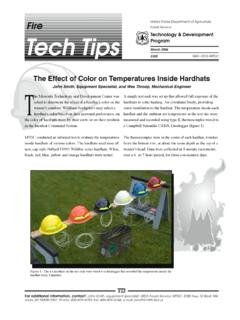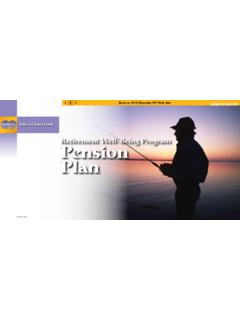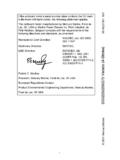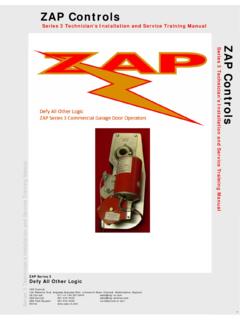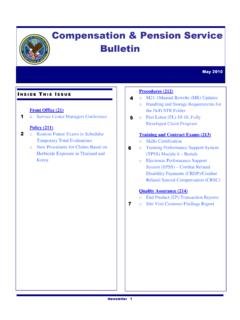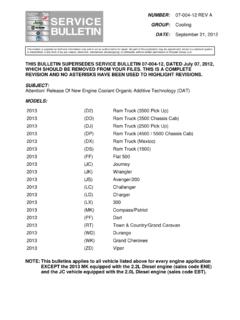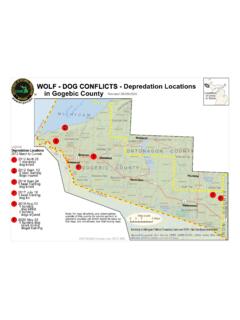Transcription of LESSONS LEARNED FROM THE USDA FOREST SEVICE …
1 LESSONS LEARNED . FROM THE USDA FOREST SEVICE community - based watershed restoration . PARTNERSHIPS. An Assessment of the Accomplishments, Limitations, and Transferable Knowledge June 2006. Bob Doppelt and Greta Onsgaard Factor 10 Inc. Box 51341. Eugene, Oregon 97405. Acknowledgements This report was produced by Bob Doppelt, Principal, and Greta Onsgaard, program assistant with Factor 10 Inc., under a contract from the USDA FOREST Service. Factor 10. Inc. is a consulting firm specializing in the analysis, development, and evaluation of sustainable development organizational change strategies. The authors wish to thank Diana Graves, Policy Analysis, Programs, Legislation, and Communication Deputy Area office as well as Karen Solari, Cooperative Forestry, State and Private Forestry Deputy Area in the Washington Office of the FOREST Service, for their help with the project. We also thank the many current and former participants in the FOREST Service community - based watershed restoration partnership who took time to complete questionnaires and speak with us about the program.
2 Table of Contents Executive Introduction, Background and Purpose of the LESSONS LEARNED Overall Specific Summary of on-the-ground Summary of socio-economic Summary of partnership - based Summary of internal FOREST Service 10. Limitations and Summary of obstacles to successful partnership Summary of obstacles to internal FOREST Service organizational 15. LESSONS LEARNED and LESSONS LEARNED from the USDA FOREST Service community - based watershed restoration Partnerships Executive Summary This report assesses the successes, limitations, knowledge and LESSONS that can be obtained from the large-scale marshalling of people and resources involved with the USDA FOREST Service community - based watershed restoration Partnerships (CBWRP). In 1999, the FOREST Service initiated the CBWRP with the goal of testing innovative approaches to landscape-level, partnership - based land and water restoration . Fifteen watersheds located across the nation were involved in the program and the FOREST Service invested over $100 million in the effort.
3 In 2002, a formative review of the CBWRP was completed for FY 2000 through 2002. This " LESSONS LEARNED " report builds on the 2002. review and provides a comprehensive assessment of the CBWRP from FY2000-05. The assessment methodology included a combination of questionnaires and phone interviews. Five key overall findings resulted from our study: 1) The CBWRP produced many notable economic, social, and environmental achievements; 2) The CBWRP. accomplished its goal as a learning lab; 3) The most important long-term outcome may be an expanded way of thinking; 4) Most programs that struggled or failed to live up to their initial goals did not expand their way of thinking; 5) As with many experiments in large organizations, the FOREST Service has struggled to embed the knowledge generated by the CBWRP in its internal systems and structure. The study found that the CBWRP produced a significant number of on-the-ground accomplishments ranging from restoring thousands of acres of riparian, uplands and wetlands, completing numerous instream habitat improvement projects, wildfire improvements, and other projects.
4 The CBWRP also produced some important socio- economic benefits. For example, based on the data provided to us, all told over 2000. people were involved, over 220 people were employed in some capacity (full, part time, temporary or contract), and materials or services were purchased from 83 businesses. Our review found that the CBWRP produced a number of achievements regarding its ability to develop effective partnerships. For example: a) FOREST Service leadership was the driving force behind the development and success of most watershed partnerships; b). The CBWRP was most successful where it fully engaged local civic capacity; c) Most CBWRP projects enhanced local networking and communication; d) Most CBWRP. projects generated increased understanding and awareness among participants; e) The CBWRP increased support for the FOREST Service within many communities; and f) The CBWRP fostered a number of new initiatives.
5 The CBWRP also produced a number of achievements related in internal FOREST Service operations. For example: a) The CBWRP created an opportunity for visionary agency i employees to step forward; b) Although often temporary, new positions were created within the agency to coordinate the CBWRP; c) The CBWRP demonstrated that the agency could successfully take on big complicated challenges; d) In some cases, the CBWRP won awards and provided a model for others. Although the CBWRP produced many achievements, a number of obstacles were identified through our review that constrained success. Understanding the nature of these constraints may allow the FOREST Service to improve its ability to engage in landscape- level, partnership - based restoration . For example: a) Not all CBWRP partnerships were successful or seen as valuable; b) Although vital to initiating watershed programs, the timing and amount of funding provided by the FOREST Service was often problematic; c).
6 The loss of funding threatens the remaining ongoing programs; d) Where FOREST Service employees or its partners saw the CBWRP simply as a source of additional funding the partnership , the program struggled or failed to deliver long-term outcomes; e) The competitive nomination process used to launch the initiative caused start-up problems for some programs; f) The FOREST Service sometimes created false expectations related to funding which led to disappointment and cynicism among partners; g) Some people question how funding was used; h) The geographic scope of some partnerships was too large; and i) Some of the watershed partnerships failed to produce a common vision or gain the commitment consistent participation needed among partners. A number of constraints specifically related to internal FOREST Service operations were also identified. For example, many of those we interviewed told us the agency often: a).
7 Lacked sufficient technical expertise and staff to effectively participate in landscape- level, partnership - based restoration ; b) Lacked support and involvement in the CBWRP. at all levels of the organization; c) Did not adequately support employees who were visionary leaders; d) Has not resolved tension between the requirements of landscape- level, partnership - based restoration and traditional FOREST Service "inside the green line". approach, which in some (but not all) National Forests makes it difficult for agency staff to fully engage in the new model. based on these strengths and limitations, we identified seven major LESSONS or areas of enhanced knowledge that the FOREST Service can use to increase its ability to operate landscape-level, partnership - based restoration programs: 1) The first and most important lesson that can be obtained from the CBWRP is that when organized, structured and funded effectively, in many situations landscape-level, partnership - based restoration is a preferred approach because it is more practical, efficient, effective, and appealing to the public.
8 We therefore recommend that the FOREST Service carefully examine the benefits of this approach and determine where, when, and how the agency can use it to resolve many of the challenges it faces today. 2) The second lesson that can be taken from the CBWRP is that partnership - based programs are most likely to succeed where civic capacity is high. We therefore ii recommend that, when possible, the FOREST Service should prioritize partnership - based programs in regions where civic capacity is high. However, it is often areas without high civic capacity that require significant restoration work. In this case, the FOREST Service may need to invest considerable time and resources cultivating influential public and private community leaders prior to launching major restoration projects. This approach would reassert a historic FOREST Service tradition of involvement in local community activities. 3) The third lesson that can be taken is the importance that visionary energetic agency employees (and partners) play in organizing partnerships, resolving complex problems, and producing success.
9 We therefore recommend that the agency make it a priority to identify and provide employees who have the ability to think differently with the flexibility and time to engage in partnerships and test out innovative solutions, even if their styles may run counter to agency norms. 4) A fourth lesson LEARNED is that a long time horizon and clear participation guidelines are necessary for success in landscape-level, partnership - based programs. We therefore recommend that, if the FOREST Service wants to engage in the new approach, it must make a long-term commitment of funding and resources and make the terms of engagement clear to all potential partners and participants. 5) A fifth lesson is that enhanced understanding and skills among FOREST Service employees are required for long-term success with landscape-level, partnership - based restoration . We therefore recommend that the agency promote internal staff education and training programs and encourage and support staff attendance in external professional development training programs.
10 In addition, education and training programs should be offered to public, private, and non-profit partners involved with partnerships. 6) A sixth lesson, one that was not universally held but was nevertheless a common theme, is that many FOREST Service employees said the conflicts between landscape-level, partnership - based restoration and the traditional "inside the green line" agency approach diminished their ability and commitment to participate in watershed partnerships. We therefore recommend that the FOREST Service clearly declare its intentions regarding landscape-level, partnership - based restoration and let employees and its partners know the extent to which the organization is committed to this approach. 7) The final overall lesson that can be taken from the CBWRP is that the greatest benefits of the initiative will accrue only if specific steps are taken to embed the new approach in the core structures and systems of the FOREST Service.







